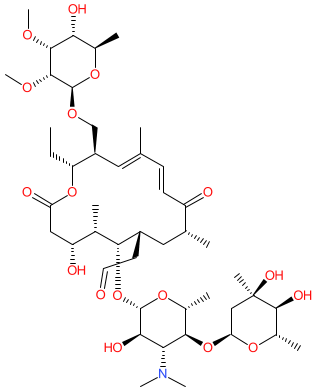|
Synonyms: tylosin A
Compound class:
Natural product
Comment: Tylosin is a 16-membered macrolide antibacterial compound produced by a strain of Streptomyces fradiae. It is used in veterinary medicine.
|
|
2D Structure
|

|
Physico-chemical Properties
|
|
|
Hydrogen bond acceptors
|
18
|
|
Hydrogen bond donors
|
5
|
|
Rotatable bonds
|
13
|
|
Topological polar surface area
|
238.67
|
|
Molecular weight
|
916.1
|
|
XLogP
|
0.79
|
|
No. Lipinski's rules broken
|
3
|
Generated using the Chemistry Development Kit (CDK) (Willighagen EL et al. Journal of Cheminformatics vol. 9:33. 2017, doi:10.1186/s13321-017-0220-4; https://cdk.github.io/)
|
SMILES / InChI / InChIKey
|
|
|
Canonical SMILES
|
CC[C@@H]1[C@H](/C=C(\C)/C=C/C(=O)[C@H](C)C[C@H](CC=O)[C@@H]([C@@H](C)[C@@H](CC(=O)O1)O)O[C@H]2[C@@H]([C@H]([C@@H]([C@@H](C)O2)O[C@H]3C[C@](C)([C@H]([C@H](C)O3)O)O)N(C)C)O)CO[C@H]4[C@@H]([C@@H]([C@@H]([C@@H](C)O4)O)OC)OC
|
|
Isomeric SMILES
|
CC[C@@H]1[C@H](/C=C(/C=C/C(=O)[C@@H](C[C@@H]([C@@H]([C@H]([C@@H](CC(=O)O1)O)C)O[C@H]2[C@@H]([C@H]([C@@H]([C@H](O2)C)O[C@H]3C[C@@]([C@H]([C@@H](O3)C)O)(C)O)N(C)C)O)CC=O)C)\C)CO[C@H]4[C@@H]([C@@H]([C@@H]([C@H](O4)C)O)OC)OC
|
|
InChI
|
InChI=1S/C46H77NO17/c1-13-33-30(22-58-45-42(57-12)41(56-11)37(52)26(5)60-45)18-23(2)14-15-31(49)24(3)19-29(16-17-48)39(25(4)32(50)20-34(51)62-33)64-44-38(53)36(47(9)10)40(27(6)61-44)63-35-21-46(8,55)43(54)28(7)59-35/h14-15,17-18,24-30,32-33,35-45,50,52-55H,13,16,19-22H2,1-12H3/b15-14+,23-18+/t24-,25+,26-,27-,28+,29+,30-,32-,33-,35+,36-,37-,38-,39-,40-,41-,42-,43+,44+,45-,46-/m1/s1
|
|
InChI Key
|
WBPYTXDJUQJLPQ-VMXQISHHSA-N
|
Generated using the Chemistry Development Kit (CDK) (Willighagen EL et al. Journal of Cheminformatics vol. 9:33. 2017, doi:10.1186/s13321-017-0220-4; https://cdk.github.io/)
|
|








